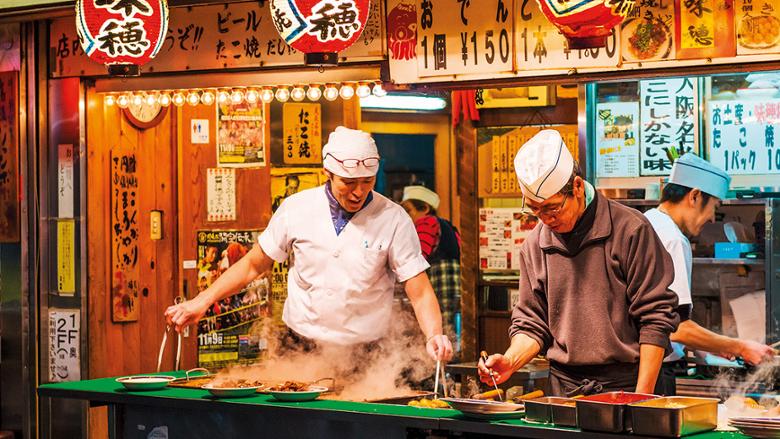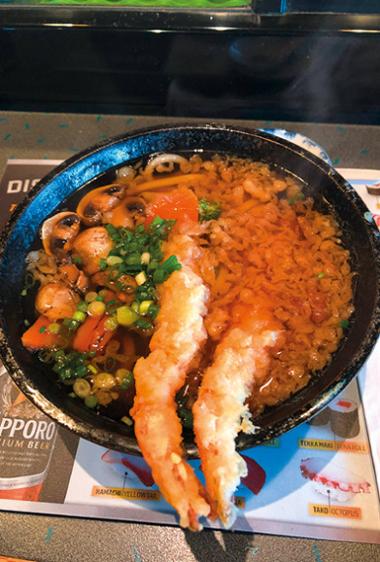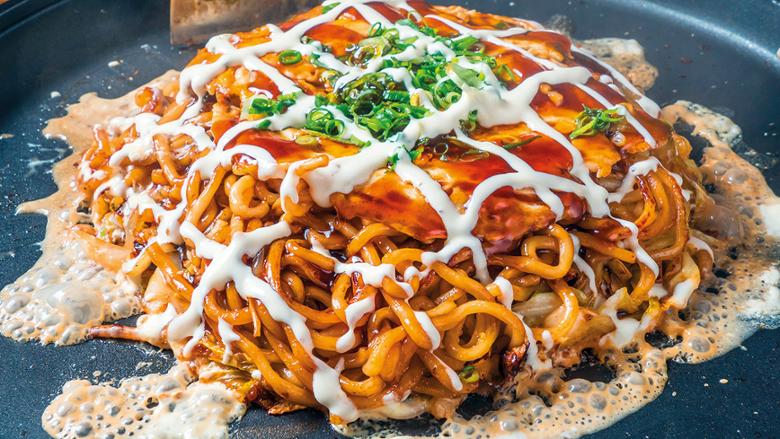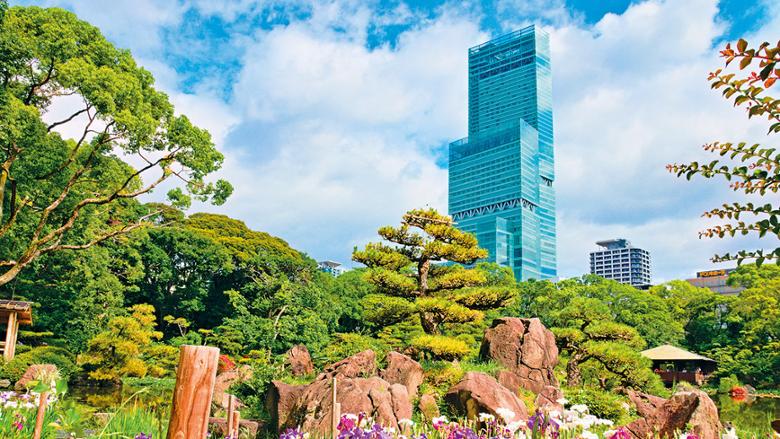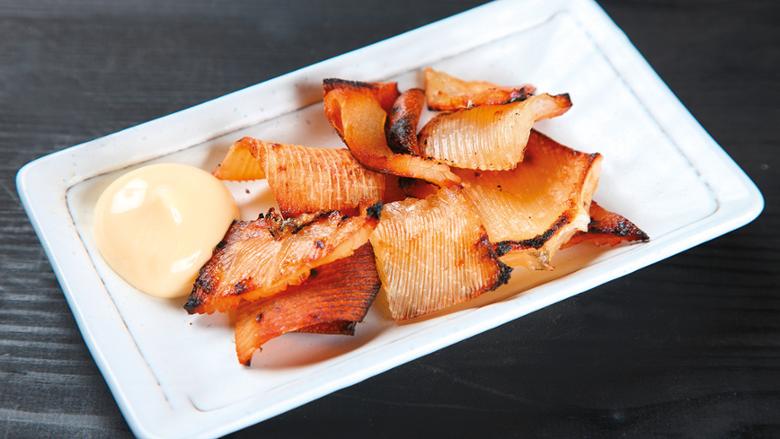Travel to Osaka, where food is a way of life
Japan’s second city and the ‘nation’s kitchen’ is the world’s fastest-growing tourist destination, finds Hannah Summers
I’ve circled Osaka Castle, sprinkled water on to pretty shrines and gazed up at pink cherry blossom, but this is the moment I cherish the most. In front of me is a huge bowl of udon – thick, squidgy lengths of noodles in a steaming vat of broth, with two giant tempura prawns tucked into the back. Beside me an 80-something man in a leather jacket snaps a picture of his meal on his phone, before slurping up his noodles to a soundtrack of Belinda Carlisle.
This is Pekopeko, a tiny little joint where in-the-know locals gather for lunchtime feasts. Here in Osaka, Japan’s second city and ‘the nation’s kitchen’, food isn’t a function – it’s a way of life.
[Hunting for Hyrule in Hokkaido: the setting for the ‘Legend of Zelda’ games may be mythical, but Ash Bhardwaj thinks he’s found it in Japan]
For a long time it has been a destination that has been overshadowed by its neighbours – it doesn’t have the high-impact shrines and temples of nearby Kyoto, or the vastness of Tokyo and its kooky cafes. And yet it’s an increasingly popular underdog. For the past two years it has been the fastest growing tourist destination in the world. In 2009, 1.7 million tourists visited; in 2018 it was up to 11.4 million.
What Osaka does have, though, is access – Emirates flies direct from Dubai – and restaurants. Thousands of them. Micro bars are tucked down alleyways and Michelin-starred restaurants hide behind ornately carved lattice screens – in fact, Osaka is so food-obsessed that its unofficial slogan is kuiadaore, meaning “eat ‘til you drop”. Clearly I’ll fit right in.
My three-day food odyssey begins in tiny Pekopeko. It isn’t the kind of place you stumble on – its location, right underneath a flyover, helping that. I find its oil-slicked walls and its elderly owner, who stuffs five lollipops into my hands for dessert, on the recommendation from Yoko Inagaki, who runs food tours and cooking classes via her company Osaka Foodie.
I meet Yoko the following day, and we set out on a mission to take on the best of the city’s signature snacks, from takoyaki, golden, deep-fried octopus and batter balls with a crispy shell and a molten centre, to okonomiyaki, a pancake-esque concoction of egg and shredded cabbage topped with lashings of sauce and bonito.
We start in Dotonbori, where zingy neon lights sit shoulder to shoulder with two-storey-high plastic models of crabs, sushi and ramen – or whatever the restaurant is selling.
The city, for all its culinary kudos, is not the prettiest place you’ll visit – despite its other nickname ‘the Venice of the East’. Gleaming high rises have replaced homes flattened during the Second World War, but the Shochikuza Theatre, built in 1923, remains. Today, locals visit to watch kabuki shows, grabbing a bento box to eat during the interval from a nearby shop, Hirajyu, plus a lottery ticket, which enters buyers into a draw to win a slab of pricey wagyu beef. [Dubai, take note.]
We pass Genroku, the restaurant that introduced the concept of conveyor-belt sushi to the country, making the previously pricey raw fish and rice combo accessible to the masses, and settle on Kamukura, Yoko’s favourite ramen restaurant. She places our order using the ticket booth-esque machine inside, and we slide onto a counter seat before a plate of oishi ramen is placed in front of us. Then Yoko teaches me the basics of Osakan eating etiquette. ‘Slurp loudly,’ she says, ‘to make sure the chefs have a good feeling.’ And the most important one: ‘No double dipping – it’s very rude.’
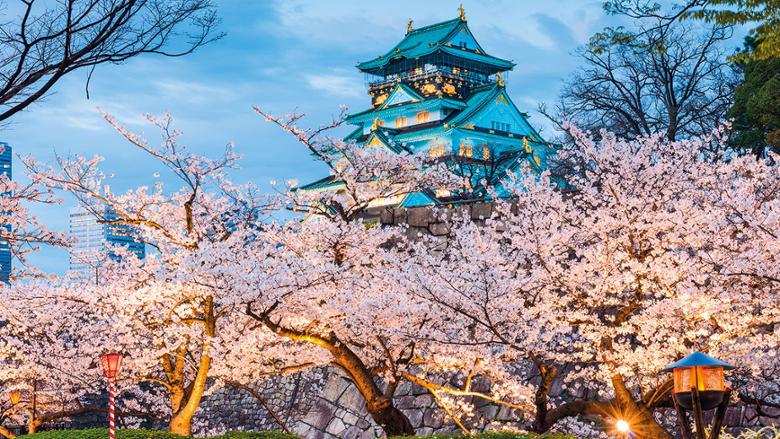
We walk it off, negotiating the city’s cobbled backstreets, making a pit stop at the tiny Hozenji temple that has been located here since 1637, and was one of the few temples to survive the bombing raids.
I follow the lead of the elderly lady next to me, dropping coins into a wooden box and hurling water on to a moss-covered statue of Buddhist spirit Fudo Myo-o, followed by a wish of my choice. ‘I always ask for a good shift at my friend’s restaurant, Unkaku,’ Yoko tells me, ‘that I don’t drop their antique plates and break them.’ Osakans take their crockery seriously, she explains.
We stroll on to Kuromon market, where dozens of food stalls are crammed with boxes of ultra-fresh sushi and punnets of giant strawberries, some bright red, some bright white, others dusty pink.
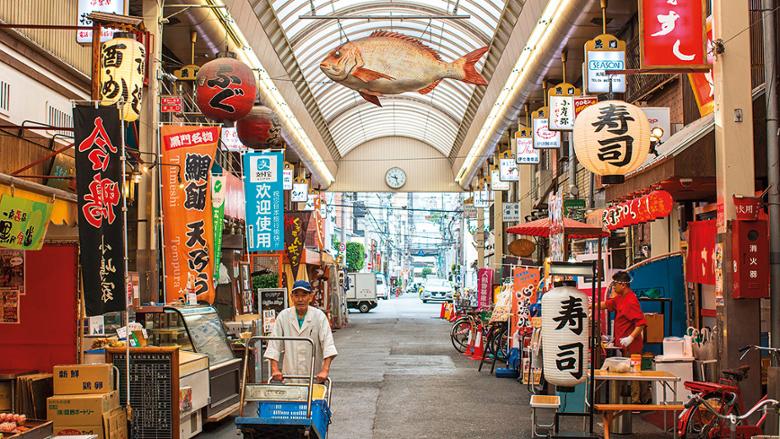
At Hamafuji we pause for a portion of another Osakan delicacy: puffer fish. It’s prepared in front of me, the poisonous guts of the fish removed, the rest grilled. I tentatively take a bite; it’s meaty, salty and surprisingly delicious – really.
That evening I fancy a swankier setting. Eating on the street is a relatively new thing for Osaka, something that has only taken hold over the past five years, so you’ll find excellent sit-down options at every turn. I go for President Chibo, a restaurant that’s been serving okonomiyaki to its customers since 1973. I watch the chef prepare a luxe version of the simple pancake, but it’s merely an amuse bouche for the main event – a thick chunk of silky miyazaki beef, a type of wagyu that’s racked up awards as one of the best beefs in the country for three consecutive years.
If there’s one thing that the Osakans love as much as their food, it’s their beverages. And they can be seen in the backstreets – tiny little izakaya (Japanese pubs), holes in the wall and “snack bars” that are stylish places where you can also try karaoke.
My favourite is Kendanka, which you access via a lift in an office-type building. Taiji Nakamura, the 80-year-old owner and Japanese equivalent of Paul McCartney, is there on my visit, tapping the tambourine while I belt out Celine Dion and Cher.
The next day I need a little peace and quiet. I find it at Keitakuen Garden, the most glorious, people-free park that’s surrounded by high rises and the city’s tallest building. Some people sit beneath cherry blossom with bento boxes, others just take in the serenity and sunshine. It’s a short walk from here to Shinsekai, home to the Tsutenkaku Tower, the city’s version of the Eiffel Tower.
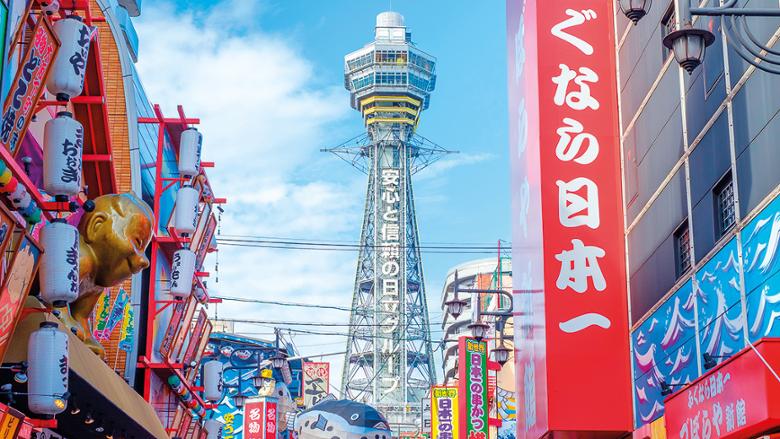
I bypass it in favour of Tower Knives, where hundreds of magnificent kitchen knives are on display. I try a few, slicing carrots and comparing blades – the pricier the knife, the more it retains the flavour of the fish or vegetable. Some customers have been known to slap about Dh32,000 on a credit card during a visit; instead I go for a modest but perfectly respectable 6.7in Santoku knife – the Ford Fiesta of the kitchen knife world, and a relative steal at Dh500.
It would be rude to leave the neighbourhood without trying its signature dish, kushikatsu. I settle in at a nameless restaurant neighbouring a few retro arcades, and try deep-fried potato lined with spicy cod roe, lotus root, aubergine and some yakitori – chicken thigh, liver and heart. A table sign reminds me of Yoko’s previous advice. ‘If you double dip, you die,’ it reads. Understandably, the warning works.
A midafternoon lull is a given on any city break, especially one where you eat, and eat, and eat. Osaka has its fill of hip cafes, and was even the birthplace of the tea ceremony, but for a real hit of caffeine you need to head to the old-school coffee shops.
My favourite is Mazuru, which transports me back to the Seventies in a spaceship-style space. Inside, people of all ages sit on beige leather armchairs and velvet seats, guzzling the city’s cheapest coffee (under Dh5 a cup) in a fog of smoke. Bizarrely, but quite commonly here, it’s located in the basement of an office block, and is worth a visit if only to meet the 99-year-old owner, who stands at the entrance greeting every customer who comes and goes.
There’s time for one last session. While I could easily spend two weeks in downtown Osaka, I want to see more. I enlist the help of Koh, a young guy who runs food and drink tours of his neighbourhood via Airbnb Experiences, and we meet in his neighbourhood of Juso, a 10-minute ride from Umeda station.
My favourite is hidden down a shopping arcade – one I’d never have ventured down on my own – where a small door opens up to a restaurant crammed with standing tables and smoke-stained walls. We try a few snacks, including roasted eihire, or stingray fin – ethically questionable but a Japanese delicacy and surprisingly delicious – followed by wasabi leaves.
‘Another?’ Koh asks me.
In Osaka, the answer is always yes.
The Daily Telegraph
